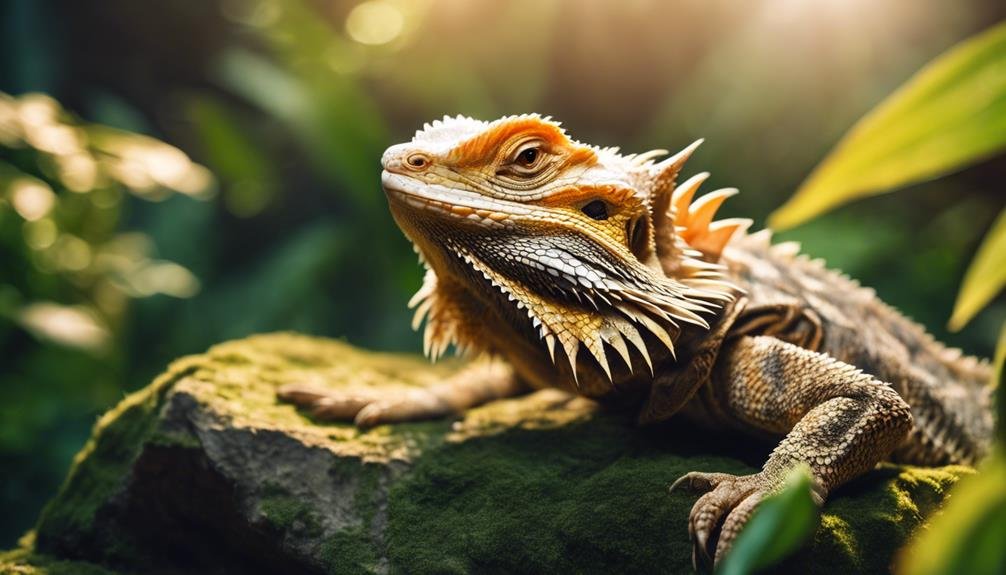If you’re considering adding a German Giant Bearded Dragon to your collection, you’ll find these reptiles fascinating due to their impressive size and unique features. Originating from selective breeding programs in Germany, these dragons sport distinctive rounded facial features and chubbier beards that set them apart. However, it’s not just their appearance that makes them unique. You’ll need to fulfill specific care requirements to ensure they thrive, particularly regarding diet, lighting, and space. So, what exactly does it take to care for one of these giants properly?
Key Takeaways
- German Giant Bearded Dragons are selectively bred for larger size, reaching up to 21 1/2 inches in length and 543 grams in weight.
- Originating from German zoo stock, they exhibit rounded facial features and chubbier beards than regular bearded dragons.
- They achieve full size around 14 months old and are typically tan or grey.
- When purchasing, consider reputable breeders and the dragon’s age, and expect costs ranging from $150 to $500.
- Ensure a balanced diet with leafy greens, vegetables, and insects, and avoid toxic foods like avocado and fireflies.
Overview of German Giant-Bearded Dragons
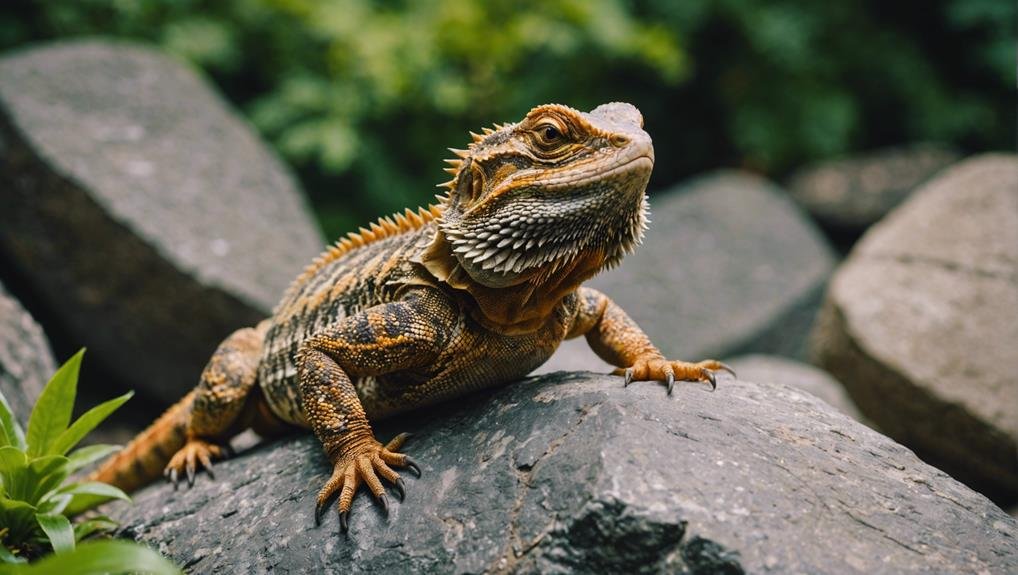

German Giant Bearded Dragons are frequently recognized for their impressive size and robust build, making them a standout among bearded dragon enthusiasts. These giants originated from German zoo stock and were selectively bred to achieve their larger size.
If you’re fascinated by big, hearty reptiles, German Giant Bearded Dragons are a prime example of how selective breeding can enhance specific traits.
Unlike your typical bearded dragons, German Giants can reach an impressive 21 1/2 inches in length and weigh up to 543 grams. These bearded dragons are a sight to behold, achieving their full size around 14 months old. Thanks to careful selective breeding practices, their lineage has notably influenced the genetics of many bearded dragons in homes today.
When breeders focused on creating German Giant Bearded Dragons, they didn’t just aim for size. They also emphasized maintaining desirable color traits, ensuring these dragons aren’t only larger and visually striking.
Identifying Characteristics
One of the most striking identifying characteristics of German Giant Bearded Dragons is their noticeably larger body mass and length compared to typical bearded dragons. These giants can grow much larger than average, making them stand out in any collection. You’ll immediately notice their rounded facial features, especially around the eyes, and their chubbier beards, giving them a distinct and endearing appearance.
These traits aren’t just due to random variations; they’ve been selectively bred from German zoo stock imported into the U.S. While they don’t form a separate species from their wild counterparts, the focus on breeding for size has made them notably larger than normal bearded dragons. If you ever need to verify whether a bearded dragon is a German Giant, look for these key features.
The original German Giants typically sported a tan or gray color, which differs from the high-color varieties seen in other bearded dragons. Notably, these characteristics make them unique.
If you have any questions or need further information, you might want to contact specialized breeders via their email addresses. This way, you can guarantee you’re getting accurate information from a reliable source.
Size Comparison
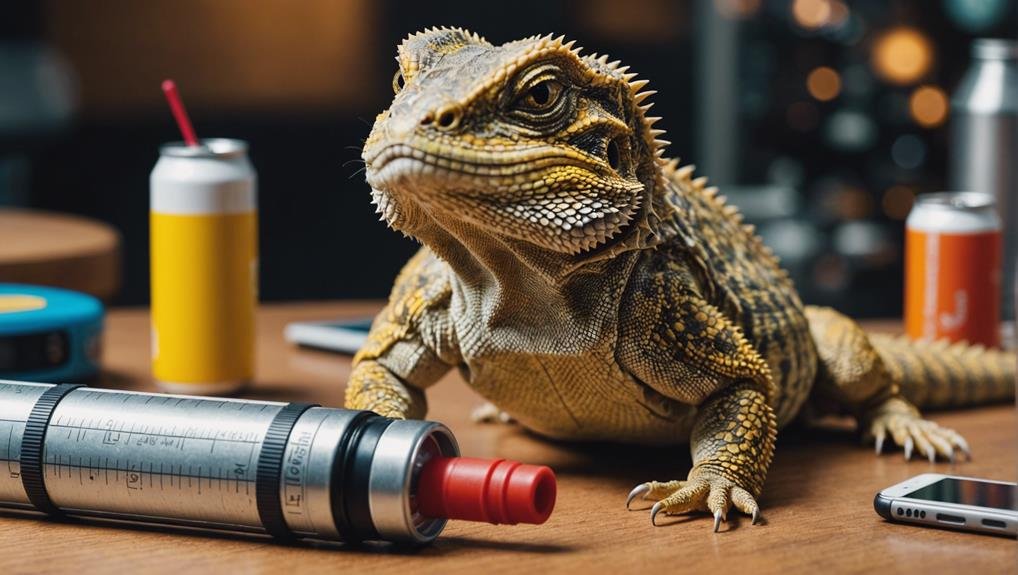

You’ll quickly notice the substantial size difference between these impressive German Giants when comparing them to regular bearded dragons. From early on, their growth milestones indicate they’re on a different trajectory. By reaching around 14 months, they’ve typically achieved their full size, setting them apart from their smaller counterparts.
Regarding length measurements, German Giant Bearded Dragons can reach an impressive 21 1/2 inches, dwarfing the 16-18 inches that regular bearded dragons usually max out at. This additional length isn’t just about the tail—it’s a robust and muscular build that contributes to their overall grandeur.
Let’s discuss weight differences. A full-grown German Giant can weigh up to 543 grams, whereas a regular bearded dragon typically weighs between 280 and 510 grams. That extra heft makes a noticeable difference when handling or observing them in their habitat.
These weight and length measurements aren’t mere numbers—they showcase the German Giant Bearded Dragon’s unique characteristics and impressive presence. When you see one next to a regular bearded dragon, the sheer size difference is undeniable and fascinating.
Legal Considerations
Before breeding German Giant Bearded Dragons, you should know the legal considerations and regional regulations involved. Different regions have specific breeding restrictions that you must follow to ensure compliance with local laws. For example, breeding hybrid reptiles in New South Wales (NSW) is legal, provided you adhere to species-specific licensing requirements. You must complete the appropriate paperwork and include species codes when applying for your breeding license.
Verifying any claims about illegal inter-species breeding is important, particularly in Australia, where misinformation can easily spread. Forums such as Aussie Pythons & Snakes often have users seeking clarification on the legality of breeding German Giant lines, so be sure to consult reliable sources or authorities if you have any doubts.
Hybrid legality can be a complex issue, varying not only by country but also by state or territory. Complying with local regulations is vital to avoid legal complications. Always check the latest laws and guidelines from your regional wildlife or environmental authority, and don’t hesitate to correct any misinformation you encounter. Your due diligence will help you navigate the breeding process responsibly and legally.
Purchasing Tips
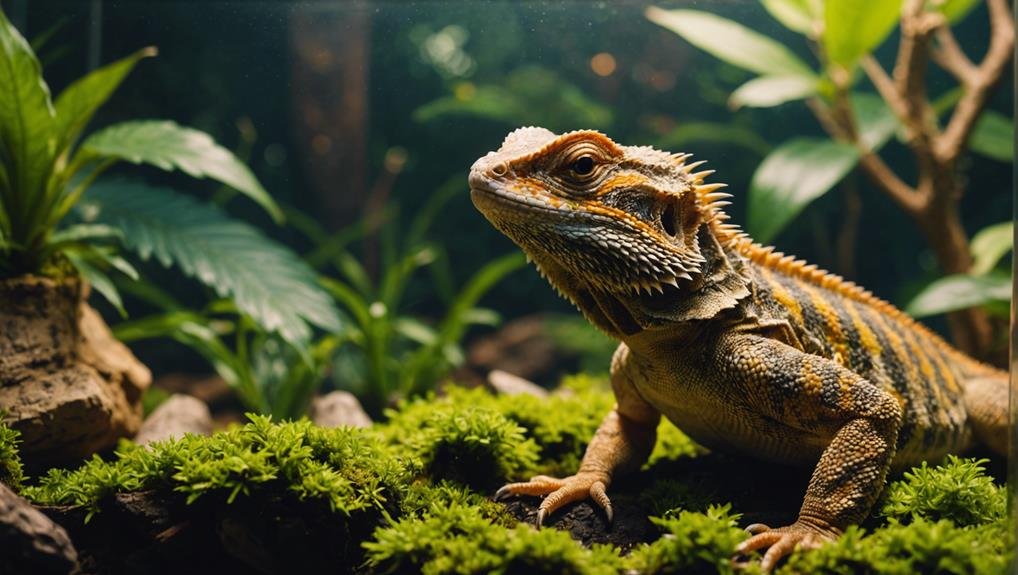

Frequently, purchasing a German Giant Bearded Dragon demands meticulous research to guarantee you’re acquiring a healthy and well-bred pet. Start by exploring all your buying options, focusing on reputable breeders rather than pet stores to secure quality. Online marketplaces like MorphMarket and reptile conventions like Repticon are excellent places to find these unique reptiles.
When considering the price, be prepared for costs ranging from $300 to $500, though you might occasionally find one for as low as $150. Price can vary based on color variations and lineage, so remember. Additionally, don’t overlook age factors; younger dragons might adapt better to new environments, whereas older ones could have established health issues.
To make an informed decision, follow these steps:
- Research reputable breeders: Ensure they have a strong reputation and positive reviews.
- Compare prices: Understand the price variations based on color and lineage.
- Consider the dragon’s age: Younger dragons are often more adaptable.
- Evaluate breeder reputation: A well-known breeder is likelier to provide a healthy pet.
Enclosure Requirements
Creating an ideal enclosure for your German Giant Bearded Dragon is essential for your health and well-being. Start by making sure the habitat essentials are in place. You’ll need at least a 100-gallon setup for an adult German Giant. This space requirement is important because these dragons grow larger and need ample room to move freely and engage in natural behaviors like basking and exploring.
Next, focus on the lighting needs. Proper lighting is essential for your dragon’s health. You’ll need UVB lighting to help them synthesize vitamin D3, which aids calcium absorption. Make sure the UVB light covers a significant portion of the enclosure. A basking light should also create a temperature gradient, with a basking spot around 95-105°F and cooler areas around 75-85°F.
Ventilation is another key aspect. Proper airflow helps maintain the right humidity levels and prevents respiratory issues. Include hides, branches, and perches to simulate a natural environment, providing security and stimulation. Ensure water bowls are always clean and accessible.
Feeding Guidelines
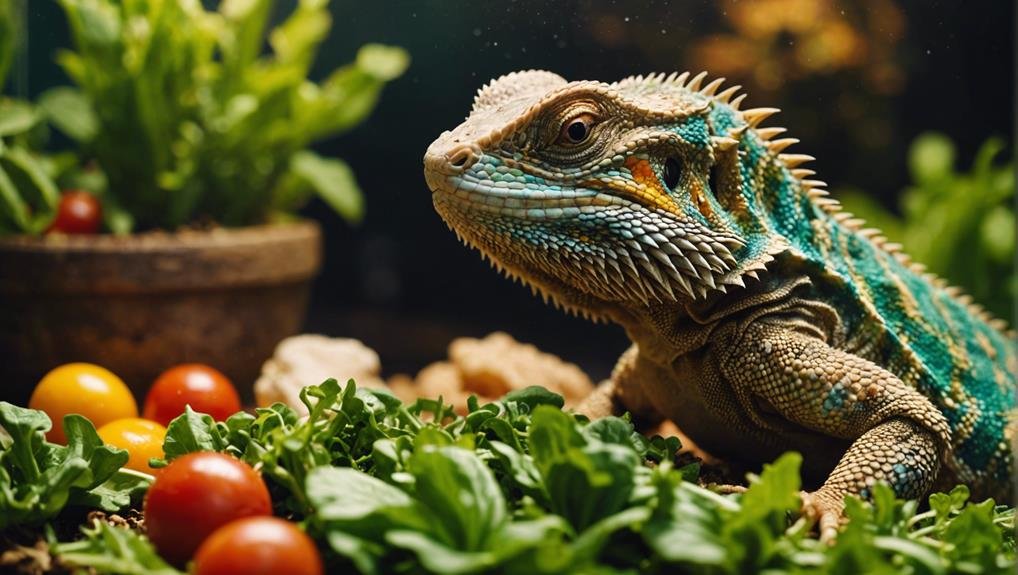

Feeding your German Giant Bearded Dragon a balanced diet is essential for maintaining health and vitality. Understanding their feeding habits and nutritional needs will help you provide the right mix of food.
Here are some key aspects to keep in mind:
- Feeding Schedule: Juveniles need daily feeding to support their rapid growth, whereas adults can be fed every other day. Be consistent with their feeding schedule to meet their dietary requirements.
- Insect Options: Offer a variety of gut-loaded and calcium-dusted insects, such as crickets, roaches, and mealworms. These provide protein and essential nutrients.
- Vegetable Variety: Incorporate leafy greens like collard greens and vegetables like squash and bell peppers. These veggies supply essential vitamins and fiber.
- Avoid Toxic Foods: Certain foods, such as avocado, rhubarb, and fireflies, are toxic to German Giants and should never be fed to them.
Health and Wellness
To guarantee your German Giant Bearded Dragon thrives, it’s important to prioritize its health and wellness alongside its diet. Begin by ensuring you meet its dietary requirements, providing a balanced mix of insects, leafy greens, and occasional fruits.
Proper UVB lighting and temperature gradients are essential to prevent common illnesses like metabolic bone disease and respiratory infections.
Regular health check-ups are critical to monitoring your dragon’s weight, skin condition, and overall well-being. Watch for behavioral changes, appetite fluctuations, and abnormal shedding, as these can indicate underlying health concerns. Prompt veterinary care is crucial if you notice any signs of parasites or other issues.
Environmental enrichment plays a significant role in your dragon’s health. A clean, spacious enclosure with climbing structures and hiding spots can reduce stress and promote physical activity. Regular hygiene practices, like cleaning the enclosure and bathing your dragon, help prevent infections and maintain skin health.
Engaging in bonding activities such as gentle handling and supervised exploration outside their enclosure can enhance stress management and improve your dragon’s quality of life.
Breeding Information
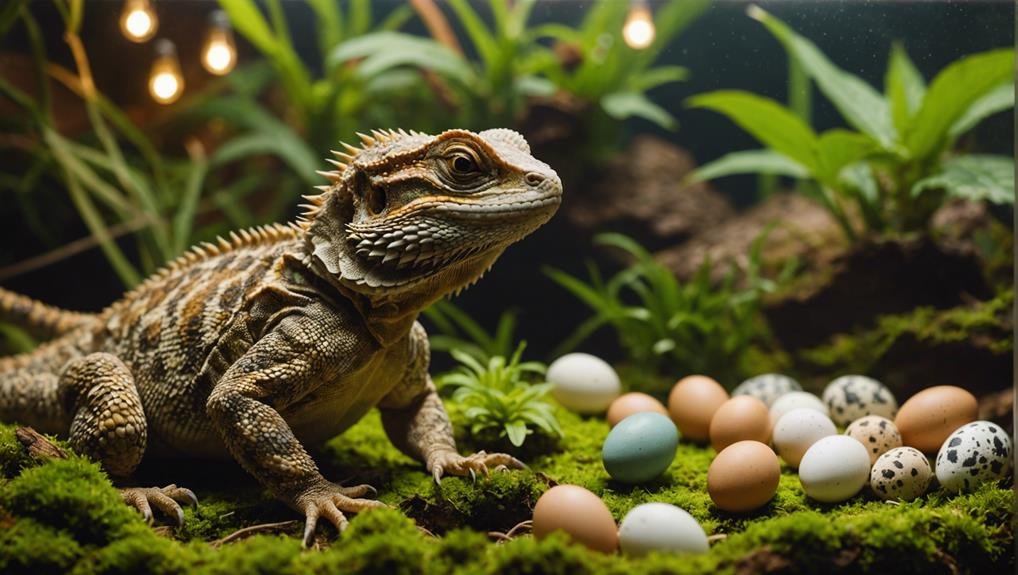

Breeding German Giant Bearded Dragons requires careful planning and attention to genetic diversity to guarantee healthy and robust offspring. Selecting the right breeding pairs is essential, as this not only preserves the size and color traits but also maintains overall genetic health.
Typically, breeding season starts in spring, a prime time for reproductive cycles.
When planning your breeding strategy, consider the following:
- Breeding techniques: Use selective breeding to ensure that only the largest and most vibrant dragons are paired, thereby retaining the hallmark traits of the German Giant.
- Genetic diversity: Avoid inbreeding by carefully tracking lineage to maintain genetic purity and robustness in your dragons.
- Growth patterns and color variations: Expect offspring to display a range of sizes and colors, reflecting genetic diversity within the population.
- Reproductive and offspring development: Monitor the reproductive cycles closely and provide ideal conditions for egg incubation and hatchling care to guarantee healthy development.
Popularity and Rarity
Thanks to their impressive size and unique traits, German Giant Bearded Dragons have become highly coveted among reptile enthusiasts. Their larger size and robust build set them apart from the more common bearded dragons, making them a standout choice for collectors and breeders alike. Breeding trends have focused on enhancing these characteristics, leading to selective breeding practices prioritizing size and appearance. This has resulted in a population of German Giants that can weigh up to 543 grams and reach lengths of up to 21 1/2 inches.
The rarity of German Giant Bearded Dragons further fuels their market demand. Due to the selective breeding required to achieve their size, they aren’t as readily available as their smaller counterparts. This scarcity makes them a prized possession in the reptile community. Collectors and breeders often go to great lengths to acquire these impressive dragons, driving their value and desirability.
Conservation efforts also contribute to the popularity and rarity of German Giants. Responsible breeding programs aim to maintain healthy genetic diversity while preserving the unique traits that make these dragons special. By balancing market demand with conservation, enthusiasts can enjoy these magnificent creatures for years.
Conclusion
In sum, if you’re considering a German Giant Bearded Dragon, you’ll find it unique with its impressive size and distinct features. It does require specialized care, but its robust build and enthralling presence make it worth the effort.
You’ll guarantee your dragon thrives by providing the right environment, nutrition, and attention. Remember, these giants are rare and sought after, so acquiring one means joining an exclusive group of dedicated reptile enthusiasts.
Related Article:
https://thereptileguide.com/leopard-gecko-diet/
https://thereptileguide.com/chameleon-facts/

